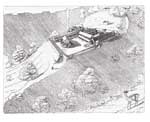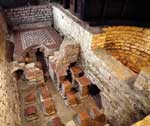 We think of villas as the grand farmhouses of the Roman countryside. But were they? Bryn Walters takes a fresh look at the evidence and comes to some radical conclusions.
We think of villas as the grand farmhouses of the Roman countryside. But were they? Bryn Walters takes a fresh look at the evidence and comes to some radical conclusions.
In the mid 20th century, Sir Ian Richmond, following on R G Collingwood, argued that for too long there had been a bland acceptance that the term ‘villa’ simply meant a grand country house. He proposed that the term ‘villa’ was a generic reference meaning a farm. A new generation of excavators has taken Richmond’s comment too literally, and concluded that any major rural structure of some opulence should automatically be seen as the core residence for an agricultural community. 
For the greater majority of villa sites in Britain, Richmond’s assessment is perfectly sound. However, it has led to an unfortunate reticence to consider that a remarkable number of sites, automatically referred to as ‘villas’, may actually have been purpose-built for other very specific functions. In any period of history, there are many structures in the countryside which are not directly associated with agricultural production, such as industrial sites, houses of penal servitude, schools, monasteries, government controlled administration or storage buildings, and large, comfortable country houses. All of these are common; should we not also expect a similarly diverse distribution in the Roman landscape?
Recent research suggests that alternative functions can be put forward for a number of the best-known ‘villas’ in Britain. Many display what might be termed ‘architectural anomalies’, where one or more of the buildings display elements in their design which are difficult to interpret in terms of a farm, or even an embellishment to a residence. Also, structural accoutrements such as barn-like buildings, malting furnaces and industrial areas, expected to be associated with agricultural practices, are often absent or have been deliberately modified or removed in a period of major alteration. Often, any religious artefacts associated with these buildings are dismissed as a casual item brought to the site and subsequently lost.
 Shrines and places of pilgrimage
Shrines and places of pilgrimage
As with the current definition of ‘villa’, it is similarly confining to expect that all buildings in the countryside, connected in some way with religious practice, must conform in design to a classical or Romano-Celtic style temple: set in a temenos, with a substantial quantity of religious artefacts and votive offerings. As a point of argument, what if the temple of Nodens at Lydney in Gloucestershire had not been incorporated into the hill-top enclosure? How would that site, with its lavish courtyard pilgrim’s lodging house, baths and abaton (sleep-house) have been interpreted ? The Chedworth ‘villa’ appears very like the Lydney ‘rest-house’ (or pilgrim’s lodging house), both extensively endowed with fine mosaic floors; the main difference is that at Chedworth the principal shrines are a little further distant from the main complex and are not incorporated within the same enclosure. There must be many other complexes mis-identified as ‘villas’ which should be categorised as a Gaulish style Tempelbezirk, as Graham Webster identified for Chedworth in 1983.
For the full article, see CA 230.



